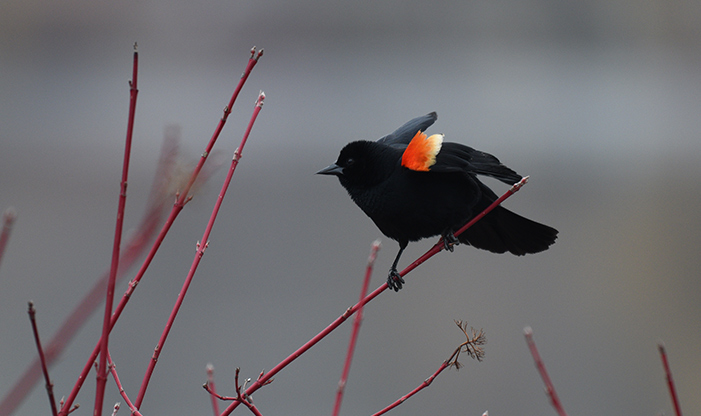An early sign of spring in Wisconsin is the trilling siren of the Red-winged Blackbird that echoes over prairies and wetlands. “Conk-la-ree! Conk-la-ree!” Those who recognize the call know to look around, as a male Red-winged Blackbird is likely perched, singing as loud as he can with his broad wings turned out to flash bright red patches lined with a yellow stripe.
Migration of the Males
When they return to their breeding habitats in early March, male Red-winged Blackbirds have one goal – to claim the largest and best territory and defend it from rival males. Males will typically return to their former territories each year. An average male territory size is 2,000 square meters, or approximately 0.5 acres. Males defend their territories by singing, fluffing plumage, spreading their tail, and raising their shoulders to display their red patches.
Red-winged Blackbirds are one of the most abundant bird species across North America. A small percentage of the population overwinter in Southern Wisconsin, though the majority migrate further south in winter to areas where they can flock together and feed on leftover grain in fields. In spring they return to their nesting habitats. Red-winged Blackbirds breed in wetland areas such as marshes or sedge meadows, as well as in crop fields. The females build their nests low to the ground or water within the vertical shoots of marsh vegetation, shrubs, or trees. The intricate nests are weaved in between stems on plants such as cattails.
The Appearance of Females
Female Red-winged Blackbirds return to their breeding grounds once insects begin to hatch, as they require a higher protein diet to lay eggs. It’s common to begin to see females by the end of March and early April. Female Red-winged Blackbirds are more drab than the males, with brownish streaks and lacking the bold red-wing of the male. This coloration allows them to camouflage into their nests. Females claim a smaller territory within the male’s territory, and the polygamous males have on average five females nesting in their territories.
Fierce Parental Protection
By April and May, nesting is in full swing, and will continue until early July, once the offspring are starting to molt. It is during this time that people typically report being “dive-bombed” by Red-winged Blackbirds on their walks outside. Once they have a nest to protect, the birds will do so with vigor, swooping down on and possibly attacking any animal that comes too close to their helpless offspring. Their goal isn’t to inflict damage but steer the potential predator away from the nesting site.
Red-winged Blackbirds are often considered a sign of spring, and their arrival is an exciting phenomenon to birders who watch for them. Their eccentric behaviors are always a unique experience to witness. People can be on the lookout for the timely appearance of Red-winged Blackbirds happening right outside their door and garner a deeper appreciation for this beautiful and also recognizable species.


